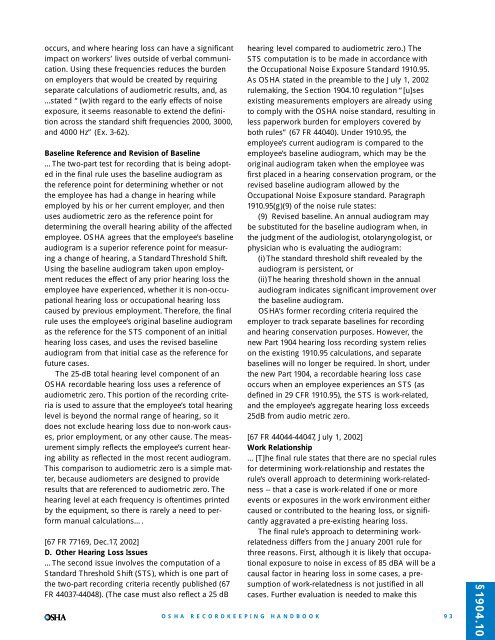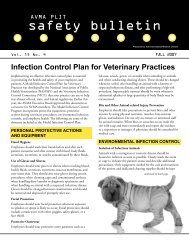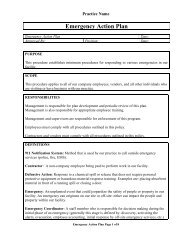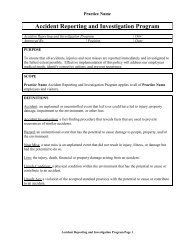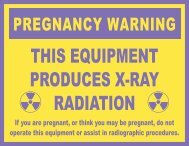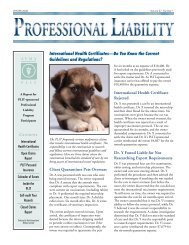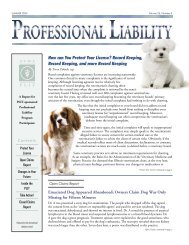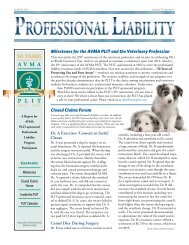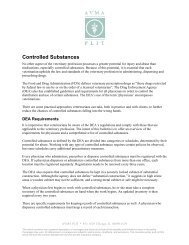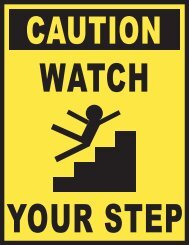§1904.1092reasonable checks against false positive results beingrecorded on the 300 Log.Age CorrectionThe final rule carries forward the January 19, 2001rule’s conceptual framework allowing, but not requiring,the employer to age adjust an employee’s annualaudiogram when determining whether or not a 10-dBshift in hearing acuity has occurred….While the final rule allows the employer to agecorrectthe STS portion of the recording criteria, thereis no allowance for age correction for determining a25-dB hearing level. The AMA Guides specificallystate that total hearing loss should not be age adjusted,and there is no recognized consensus method forage adjusting a single audiogram. The method usedin Appendix F of Section 1910.95 is designed to agecorrect STS, not absolute hearing ability. The 25-dBcriteria is used to assure the existence of a serious illness,and reflects the employee’s overall health condition,regardless of causation. Age correcting theSTS will provide adequate safeguards against recordingage corrected hearing loss. Therefore, it would beinappropriate and unnecessary to age correct the 25-dB hearing level.Persistence... The <strong>OSHA</strong> noise standard addresses the issue oftemporary hearing losses by allowing the employerto retest the employee’s hearing within 30 days(1910.95(g)(7)(ii)). The 2001 rule adopted the same 30day retest option at Section 1904.10(b)(4) by allowingthe employer to delay recording if a retest was goingto be performed in the next 30 days.... <strong>OSHA</strong> has decided not to allow a longer retestingperiod. A longer retesting period would increasethe likelihood that the employer would lose track ofthe case and therefore inadvertently fail to record thecase. These errors would have a detrimental effect onthe accuracy of the records and run counter to<strong>OSHA</strong>’s goal of improving the quality of the injuryand illness data. The Agency also believes that usingdifferent time periods for retesting in the part 1904and Section 1910.95 rules would result in increasedconfusion for employers.The Agency has also rejected the suggestion thatall hearing loss cases must be confirmed prior torecording them. Waiting for one year or longer torecord an occupational hearing loss would move therecording to a year in which the original hearing losswas not initially discovered, would be administrativelymore complex for employers, and would have adetrimental effect on the hearing loss data. Many<strong>OSHA</strong> RECORDKEEPINGlegitimate hearing loss cases could go unrecordedsimply because the employee did not receive a subsequentaudiogram due to job changes or someother circumstance that might occur before the nextannual audiogram required by the noise standard….... The <strong>OSHA</strong> noise standard at Section 1910.95(g)(3),requires that:Audiometric tests shall be performed by a licensed orcertified audiologist, otolaryngologist, or other physician,or by a technician who is certified by the Council ofAccreditation in Occupational Hearing Conservation, orwho has satisfactorily demonstrated competence inadministering audiometric examinations, obtaining validaudiograms, and properly using, maintaining and checkingcalibration and proper functioning of the audiometersbeing used. A technician who operates microprocessoraudiometers does not need to be certified. A technicianwho performs audiometric tests must be responsibleto an audiologist, otolaryngologist or physician.Because the noise standard already requiresaudiograms to be conducted by, or under the supervisionof, a qualified professional, subsequent audiogramsthat may refute the persistence of a recordedhearing loss will be reviewed by the appropriate professional.The Section 1904.10 simply cross-referencesthe need for the audiograms to be obtainedpursuant to the requirements of Section 1910.95, sothere is no need for the Section 1904.10 rule to repeatthe review requirement. . . . [T]he rule does notrequire the employer to maintain documentationconcerning the removal of cases. Section1910.95(m)(2) of the noise standard requires theemployer to keep records of all audiometric tests thatare performed, and those records will be available,should they be needed for future reference. As aresult, there is no need to add a duplicative paperworkburden in the Section 1904.10 rule. Therefore,Section 1904.10(b)(4) states that “If subsequentaudiometric testing indicates that an STS is not persistent,you may erase or line-out the recordedentry”. <strong>OSHA</strong> has added this additional regulatorylanguage to minimize the recording of temporaryhearing loss cases while capturing complete data onthe incidence of hearing loss disorders.Frequencies…<strong>OSHA</strong> has decided to continue to use the frequenciesused in the Section 1910.95 <strong>OSHA</strong> noise standard(2000, 3000, and 4000 Hz). While “most” communicationoccurs at lower frequencies, these areclearly audible frequencies where some speechHANDBOOK
occurs, and where hearing loss can have a significantimpact on workers’ lives outside of verbal communication.Using these frequencies reduces the burdenon employers that would be created by requiringseparate calculations of audiometric results, and, as...stated “(w)ith regard to the early effects of noiseexposure, it seems reasonable to extend the definitionacross the standard shift frequencies 2000, 3000,and 4000 Hz” (Ex. 3-62).Baseline Reference and Revision of Baseline…The two-part test for recording that is being adoptedin the final rule uses the baseline audiogram asthe reference point for determining whether or notthe employee has had a change in hearing whileemployed by his or her current employer, and thenuses audiometric zero as the reference point fordetermining the overall hearing ability of the affectedemployee. <strong>OSHA</strong> agrees that the employee’s baselineaudiogram is a superior reference point for measuringa change of hearing, a Standard Threshold Shift.Using the baseline audiogram taken upon employmentreduces the effect of any prior hearing loss theemployee have experienced, whether it is non-occupationalhearing loss or occupational hearing losscaused by previous employment. Therefore, the finalrule uses the employee’s original baseline audiogramas the reference for the STS component of an initialhearing loss cases, and uses the revised baselineaudiogram from that initial case as the reference forfuture cases.The 25-dB total hearing level component of an<strong>OSHA</strong> recordable hearing loss uses a reference ofaudiometric zero. This portion of the recording criteriais used to assure that the employee’s total hearinglevel is beyond the normal range of hearing, so itdoes not exclude hearing loss due to non-work causes,prior employment, or any other cause. The measurementsimply reflects the employee’s current hearingability as reflected in the most recent audiogram.This comparison to audiometric zero is a simple matter,because audiometers are designed to provideresults that are referenced to audiometric zero. Thehearing level at each frequency is oftentimes printedby the equipment, so there is rarely a need to performmanual calculations….[67 FR 77169, Dec.17, 2002]D. Other Hearing Loss Issues…The second issue involves the computation of aStandard Threshold Shift (STS), which is one part ofthe two-part recording criteria recently published (67FR 44037-44048). (The case must also reflect a 25 dB<strong>OSHA</strong> RECORDKEEPINGhearing level compared to audiometric zero.) TheSTS computation is to be made in accordance withthe Occupational Noise Exposure Standard 1910.95.As <strong>OSHA</strong> stated in the preamble to the July 1, 2002rulemaking, the Section 1904.10 regulation “[u]sesexisting measurements employers are already usingto comply with the <strong>OSHA</strong> noise standard, resulting inless paperwork burden for employers covered byboth rules” (67 FR 44040). Under 1910.95, theemployee’s current audiogram is compared to theemployee’s baseline audiogram, which may be theoriginal audiogram taken when the employee wasfirst placed in a hearing conservation program, or therevised baseline audiogram allowed by theOccupational Noise Exposure standard. Paragraph1910.95(g)(9) of the noise rule states:(9) Revised baseline. An annual audiogram maybe substituted for the baseline audiogram when, inthe judgment of the audiologist, otolaryngologist, orphysician who is evaluating the audiogram:(i) The standard threshold shift revealed by theaudiogram is persistent, or(ii) The hearing threshold shown in the annualaudiogram indicates significant improvement overthe baseline audiogram.<strong>OSHA</strong>’s former recording criteria required theemployer to track separate baselines for recordingand hearing conservation purposes. However, thenew Part 1904 hearing loss recording system relieson the existing 1910.95 calculations, and separatebaselines will no longer be required. In short, underthe new Part 1904, a recordable hearing loss caseoccurs when an employee experiences an STS (asdefined in 29 CFR 1910.95), the STS is work-related,and the employee’s aggregate hearing loss exceeds25dB from audio metric zero.[67 FR 44044-44047, July 1, 2002]Work Relationship... [T]he final rule states that there are no special rulesfor determining work-relationship and restates therule’s overall approach to determining work-relatedness-- that a case is work-related if one or moreevents or exposures in the work environment eithercaused or contributed to the hearing loss, or significantlyaggravated a pre-existing hearing loss.The final rule’s approach to determining workrelatednessdiffers from the January 2001 rule forthree reasons. First, although it is likely that occupationalexposure to noise in excess of 85 dBA will be acausal factor in hearing loss in some cases, a presumptionof work-relatedness is not justified in allcases. Further evaluation is needed to make thisHANDBOOK93§1904.10
- Page 1 and 2:
www.osha.govOSHARecordkeepingHandbo
- Page 3 and 4:
OSHARecordkeeping HandbookThe Regul
- Page 5 and 6:
ContentsRecordkeeping HandbookRoadm
- Page 7 and 8:
Section 1904.40Providing records to
- Page 10 and 11:
§1904.0…OSHA has rejected the su
- Page 12 and 13:
§1904.1Since publication of the re
- Page 14 and 15:
§1904.2SIC code Industry descripti
- Page 16 and 17:
§1904.2tinue to have injury and il
- Page 18 and 19:
Section 1904.3Keeping records for m
- Page 20 and 21:
PREAMBLE DISCUSSION: Section 1904.4
- Page 22 and 23:
(viii)(ix)The illness is the common
- Page 24 and 25:
§1904.5employment environment. For
- Page 26 and 27:
§1904.5the employee’s status as
- Page 28 and 29:
§1904.5Exceptions Proposed but Not
- Page 30 and 31:
§1904.5pain and swelling in a join
- Page 32 and 33:
§1904.5the worker has taken a side
- Page 34 and 35:
§1904.526“Personal tasks” for
- Page 36 and 37:
If the accident had occurred in a l
- Page 38 and 39:
Scenario 4:• An employee reports
- Page 40 and 41:
In applying [the presumption of wor
- Page 42 and 43:
Letters of interpretation related t
- Page 44 and 45:
November 19, 2002Joseph Woodward, E
- Page 46 and 47:
Letter of interpretation related to
- Page 48 and 49:
§1904.6that the two injuries or il
- Page 50 and 51: §1904.6…Under the OSHA recordkee
- Page 52 and 53: FREQUENTLY ASKED QUESTIONS: Section
- Page 54 and 55: Since the employee was not performi
- Page 56 and 57: In each of the eight scenarios in y
- Page 58 and 59: §1904.7other licensed health care
- Page 60 and 61: §1904.7that eliminates the routine
- Page 62 and 63: §1904.7pose. This paragraph also s
- Page 64 and 65: §1904.7Counting Lost Workdays When
- Page 66 and 67: §1904.7tors to such injuries and i
- Page 68 and 69: §1904.7This list of first aid trea
- Page 70 and 71: §1904.7visit to a health care prof
- Page 72 and 73: §1904.7However, as discussed above
- Page 74 and 75: §1904.766immediate recording of si
- Page 76 and 77: §1904.7strength? How is an employe
- Page 78 and 79: §1904.7or illness. The severity of
- Page 80 and 81: The first treatment is glue used to
- Page 82 and 83: Response: The employer would have t
- Page 84 and 85: Letter of interpretation related to
- Page 86 and 87: Letter of interpretation related to
- Page 88 and 89: §1904.8exposure” as these terms
- Page 90 and 91: ing blood and other potentially inf
- Page 92 and 93: standard. In some cases employers v
- Page 94 and 95: PART 1904—[AMENDED] (67 FR 77170,
- Page 96 and 97: §1904.1088OSHA RECORDKEEPINGcorrec
- Page 98 and 99: §1904.1090OSHA RECORDKEEPINGAwaren
- Page 102 and 103: §1904.1094determination. Second, t
- Page 104 and 105: FREQUENTLY ASKED QUESTIONS: Section
- Page 106 and 107: Also, from time to time we update o
- Page 108 and 109: §1904.11Section 1904.11Recording c
- Page 110 and 111: §1904.11of causation applies to th
- Page 112 and 113: §1904.12Thus, the total MSD count
- Page 114 and 115: §1904.12current survey was designe
- Page 116 and 117: §1904.29son’s blood or other pot
- Page 118 and 119: §1904.29cern cases, and the list m
- Page 120 and 121: §1904.29have also been designed to
- Page 122 and 123: §1904.29with that entry and employ
- Page 124 and 125: FREQUENTLY ASKED QUESTIONS: Section
- Page 126 and 127: Section 1904.29(b)(10). In addition
- Page 128 and 129: Section 1904.30Multiple business es
- Page 130 and 131: fest themselves quickly and can be
- Page 132 and 133: §1904.31The term “employee” me
- Page 134 and 135: §1904.31companies, and other tempo
- Page 136 and 137: Letter of interpretation related to
- Page 138 and 139: Scenario 5:• An employee drives i
- Page 140 and 141: Response: The log is to be kept for
- Page 142 and 143: Section 1904.32Annual summary(66 FR
- Page 144 and 145: §1904.32The company executive cert
- Page 146 and 147: Deletions from the former rule....F
- Page 148 and 149: I do want to make one further point
- Page 150 and 151:
sede any longer retention periods s
- Page 152 and 153:
Response: The controlling employer
- Page 154 and 155:
Section 1904.35Employee involvement
- Page 156 and 157:
§1904.351904 regulation to provide
- Page 158 and 159:
§1904.35tions on employees’ and
- Page 160 and 161:
employee, the employer must provide
- Page 162 and 163:
Thank you for your interest in occu
- Page 164 and 165:
Letter of interpretation related to
- Page 166 and 167:
Section 1904.36Prohibition against
- Page 168 and 169:
and section 1952.4 spells out the r
- Page 170 and 171:
§1904.38Section 1904.38Variances f
- Page 172 and 173:
§1904.38cited and the citation is
- Page 174 and 175:
§1904.39PREAMBLE DISCUSSION: Secti
- Page 176 and 177:
§1904.39FREQUENTLY ASKED QUESTIONS
- Page 178 and 179:
§1904.40maintains the records at a
- Page 180 and 181:
June 23, 2003Mr. Edwin G. Foulke, J
- Page 182 and 183:
Section 1904.41Annual OSHA injury a
- Page 184 and 185:
Section 1904.42Requests from the Bu
- Page 186 and 187:
Section 1904.43Summary and posting
- Page 188 and 189:
Section 1904.44Retention and updati
- Page 190 and 191:
Section 1904.45OMB control numbers
- Page 192 and 193:
allows him or her to independently
- Page 194 and 195:
§1904.46the three criteria above,
- Page 196 and 197:
§1904.46approach will provide an i
- Page 198 and 199:
FREQUENTLY ASKED QUESTIONS: Section
- Page 200 and 201:
Section 1952.4Injury and illness re


